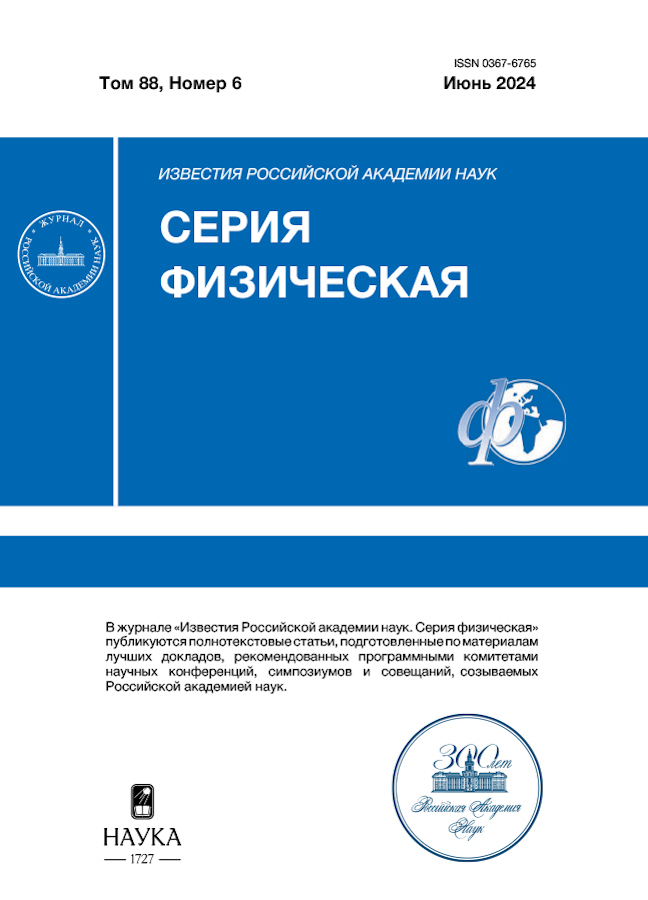Многопараметрическая квантовая метрология с использованием светлых солитонов
- Авторы: Алоджанц А.П.1,2, Царёв Д.В.1,2, Осипов С.В.3, Подошведов М.С.2,4, Кулик С.П.2,5
-
Учреждения:
- Национальный исследовательский университет ИТМО
- Южно-Уральский государственный университет (национальный исследовательский университет)
- Череповецкий государственный университет
- Казанский национальный исследовательский технический университет им. А. Н. Туполева — КАИ
- Московский государственный университет имени М. В. Ломоносова
- Выпуск: Том 88, № 6 (2024)
- Страницы: 854-861
- Раздел: Квантовая оптика и когерентная спектроскопия
- URL: https://cardiosomatics.ru/0367-6765/article/view/654649
- DOI: https://doi.org/10.31857/S0367676524060022
- EDN: https://elibrary.ru/PHNVGO
- ID: 654649
Цитировать
Полный текст
Аннотация
Рассмотрена проблема квантовой метрологии одновременного измерения и оценки нескольких фазовых параметров в парадигме современных тенденций развития альтернативной навигации. Исследованы фундаментальные пределы как линейной, так и нелинейной метрологии. Проанализировано влияние потерь на точность квантовой метрологии нескольких фазовых параметров и определены оптимальные пробные состояния для их измерения. Предлагается метод приготовления трехмодовых NооN-состояний с использованием светлых атомных солитонов.
Ключевые слова
Полный текст
Об авторах
А. П. Алоджанц
Национальный исследовательский университет ИТМО; Южно-Уральский государственный университет (национальный исследовательский университет)
Автор, ответственный за переписку.
Email: alexander_ap@list.ru
Россия, Санкт-Петербург; Челябинск
Д. В. Царёв
Национальный исследовательский университет ИТМО; Южно-Уральский государственный университет (национальный исследовательский университет)
Email: alexander_ap@list.ru
Россия, Санкт-Петербург; Челябинск
С. В. Осипов
Череповецкий государственный университет
Email: alexander_ap@list.ru
Россия, Череповец
М. С. Подошведов
Южно-Уральский государственный университет (национальный исследовательский университет); Казанский национальный исследовательский технический университет им. А. Н. Туполева — КАИ
Email: alexander_ap@list.ru
Россия, Челябинск; Казань
С. П. Кулик
Южно-Уральский государственный университет (национальный исследовательский университет); Московский государственный университет имени М. В. Ломоносова
Email: alexander_ap@list.ru
Россия, Челябинск; Москва
Список литературы
- Pezzé L., Smerzi A., Oberthaler M.K. et al. // Rev. Mod. Phys. 2018. V. 90. Art. No. 035005.
- Degen C.L., Reinhard F., Cappellaro P. // Rev. Mod. Phys. 2017. V. 89. Art. No. 035002.
- Crawford S.E., Shugayev R.A., Paudel H.P. et al. // Adv. Quantum Technol. 2021. V. 4. Art. No. 2100049.
- Bongs K., Holynski M., Vovrosh J. et al. // Nature Rev. Phys. 2019. V. 1. P. 731.
- Abend S., Allard B., Arnold A.S. et al. // AVS Quantum Sci. 2023. V. 5. No. 1. Art. No. 019201.
- Ludlow A.D., Boyd M.M., Ye J. et al. // Rev. Mod. Phys. 2015. V. 87 P. 2.
- Mitchell M.W., Alvarez S.P. // Rev. Mod. Phys. 2020. V. 92. No. 2. Art. No. 021001.
- Templier S., Cheiney P., D’Armagnac De Castanet Q. // Sci. Advances. 2022. V. 8. Art. No. eadd3854.
- Bloch I. // Nature Physics. 2005. V. 1. No. 1. P. 23.
- Сазонов С.В. // Изв. РАН. Сер. физ. 2022. Т. 86. № 6. С. 766; Sazonov S. V. // Bull. Russ. Acad. Sci. Phys. 2022. V. 86. No. 6. P. 643.
- Afanasiev A.E., Kalmykov A.S., Kirtaev R.V. et al. // Opt. Laser Tech. 2022. V. 148. Art. No. 107698.
- Sewell R.J., Dingjan J., Baumgärtner F. et al. // J. Physics B. 2010. V. 43. No. 5. Art. No. 051003.
- Царёв Д.В., Нго Т.В., Алоджанц А.П. // Изв. РАН. Сер. физ. 2020. Т. 84. № 3. С. 332; Tsarev D.V., Ngo V.T., Alodjants A.P. // Bull. Russ. Acad. Sci. Phys. 2020. V. 84. No. 3. P. 257.
- Сазонов С.В., Устинов Н.В. // Изв. РАН. Сер. физ. 2020. Т. 84. № 1. С. 11; Sazonov S.V., Ustinov N.V. // Bull. Russ. Acad. Sci. Phys. 2020. V. 84. No. 1. P. 5.
- Touboul P., Métris G., Rodrigues M. et al. // Phys. Rev. Lett. 2022. V. 129. No. 12. Art. No. 121102.
- Anglin J.R., Vardi A. // Phys. Rev. A. 2001. V. 64. No. 5. Art. No. 013605.
- Калинович А.А., Захарова И.Г. // Изв. РАН. Сер. физ. 2023. Т. 87. № 12. С. 1701; Kalinovich A.A., Zakharova I.G. // Bull. Russ. Acad. Sci. Phys. 2023. V. 87. No. 12. P. 1785.
- Joo J., Park K., Jeong H. et al. // Phys. Rev. A. 2012. V. 86. Art. No. 043828.
- Dowling L.P. // Cont. Phys. 2008. V. 49. P. 125.
- Birrittella R.J., Alsing P.M., Gerry C. C. // AVS Quantum Sci. 2021. V. 3. Art. No. 014701.
- Tsarev D.V., Arakelian S.M., Chuang Y.-L. et al. // Opt. Express. 2018. V. 26. Art. No. 19583.
- Maldonado-Mundo D., Luis A. // Phys. Rev. A. 2009. V. 80. Art. No. 063811.
- Napolitano M., Mitchell M.W. // New J. Phys. 2010. V. 12. Art. No. 09301.
- Tsarev D.V., Ngo T.V., Lee R.-K., Alodjants A.P. // New J. Phys. 2019. V. 21 Art. No. 083041.
- Alodjants A.P., Tsarev D.V., Ngo T.V., Lee R.-K. // Phys. Rev. A. 2022. V. 105. Art. No. 012606.
- Liu J., Lu X.M., Sun Z., Wang X. // J. Phys. A. 2016. V. 49. Art. No. 115302.
- Gessner M., Pezzé L., Smerzi A. // Phys. Rev. Lett. 2018. V. 121. Art. No. 130503.
- Humphreys P.C., Barbieri M., Datta A., Walm-sley I.A. // Phys. Rev. Lett. 2013. V. 111. Art. No. 070403.
- Demkowicz-Dobrzanski R., Dorner U., Smith B.J. et al. // Phys. Rev. A. 2009. V. 80. Art. No. 013825.
- Raghavan S., Agrawan G.P. // J. Mod. Optics. 2000. V. 47. P. 1155.
- Tsarev D., Alodjants A., Lee R.-K. // New J. Physics. 2020. V. 22. No. 11. Art. No. 113016.
- Tsarev D., Osipov S., Lee R.-K. et al. // Phys. Rev. A. 2023. V. 108. Art. No. 062612.
- Dorner U., Demkowicz-Dobrzanski R., Smith B. J. et al. // Phys. Rev. Lett. 2009. V. 102. Art. No. 040403.
- Humphreys P.C., Barbieri M., Datta A., Walmsley I.A. // Phys. Rev. Lett. 2013. V. 111. Art. No. 070403.
- Khaykovich L., Schreck F., Ferrari G. et al. // Science. 2002. V. 296. P. 1290.
Дополнительные файлы














